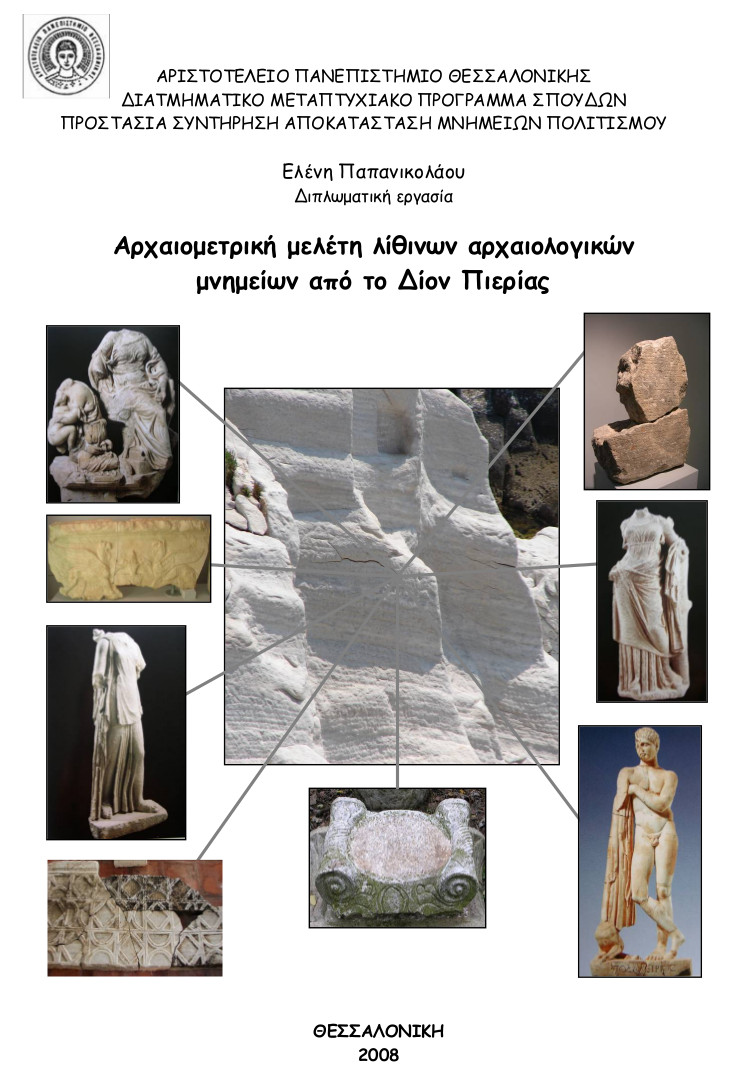
Αρχαιομετρική μελέτη λίθινων αρχαιολογικών μνημείων από το ∆ίον Πιερίας.
Περίληψη
Η παρούσα εργασία έχει σκοπό να προσδιοριστούν οι πετρολογικοί τύποι των πρώτων υλών που χρησιμοποιήθηκαν για την κατασκευή των λίθινων μνημείων καθώς και οι πηγές προέλευσης των πρώτων υλών μαρμάρινων μνημείων από τον αρχαιολογικό χώρο του ∆ίου Πιερίας. Το συγκεκριμένο ζήτημα είναι βασικό ερώτημα στην αρχαιολογική έρευνα και οι θετικές επιστήμες καλούνται να το απαντήσουν, δίνοντας μια νέα διάσταση στη μελέτη της ιστορίας των αρχαίων μνημείων. Τα μνημεία, τα οποία μελετήθηκαν χρονολογούνται από τον 2ο αι. π.Χ. έως τον 5ο αι. μ.Χ. και είναι τα εξής: άγαλμα του Ποδαλείριου από το σύνταγμα των παιδιών του Ασκληπιού, τραπεζοφόρο με σύμπλεγμα από το μύθο της Μήδειας, επιγραφή συνθήκης συμμαχίας Φιλίππου Ε ́ και κατοίκων της Λυσιμάχειας της Θράκης, σαρκοφάγος με παράσταση γρυπών, σαρκοφάγος με παράσταση αντωπών Κενταύρων εκατέρωθεν δένδρου, άγαλμα Αρτέμιδος, άγαλμα Αφροδίτης με Έρωτα, επιτύμβια στήλη, ιωνικό κιονόκρανο από τις κιονοστοιχίες του κυρίως ναού της κοιμητηριακής βασιλικής, αμφίγλυφο θωράκιο βήματος κοιμητηριακής βασιλικής, ιωνικό κιονόκρανο βόρειας στοάς αιθρίου κοιμητηριακής βασιλικής, ΒΑ λιθόπλινθος πρόναου νότιου ελληνιστικού ναού ιερού της ∆ήμητρας, πλάκα πλακόστρωσης της κεντρικής αίθουσας των θερμών του κεντρικού δρόμου του ∆ίου. Τα έντεκα πρώτα δείγματα είναι μαρμάρινα και η μελέτη απέδειξε ότι επτά (7) δείγματα προέρχονται από τα αρχαία λατομεία της Θάσου. Συγκεκριμένα, ένα (1) από αυτά προέρχεται από τα λατομεία δολομιτικού μαρμάρου του όρμου του Αγίου Ιωάννη, στα ΒΑ της νήσου, ενώ για τα υπόλοιπα έξι (6) δείγματα, πηγή προέλευσης είναι τα λατομεία ασβεστιτικού μαρμάρου της Αλυκής, στη ΝΑ Θάσο. Τέσσερα (4) δείγματα προέρχονται από τα λατομεία της Πεντέλης. ∆ύο (2) δείγματα αποτελούνται από ψαμμίτη και είναι πιθανώς τοπικής προέλευσης. Σύμφωνα με την παρούσα μελέτη προσδιορίστηκαν οι δρόμοι διακίνησης του μαρμάρου κατά την αρχαιότητα. Συνεπώς, η αρχαία πόλη του ∆ίου συνδεόταν με τα λατομεία της Πεντέλης και της Θάσου (Αλυκή, Άγιος Ιωάννης) από τους ελληνιστικούς ως τους πρώιμους βυζαντινούς χρόνους, σύμφωνα με τη χρονολόγηση των μνημείων της παρούσας εργασίας. Η αξία των συγκεκριμένων μνημείων είναι μεγάλη. Το χρονολογικό πλαίσιο στοοποίο εντάσσονται είναι μια εποχή, όπου επικρατεί ευμάρεια, διότι οι κάτοικοι παραγγέλνουν υψηλής ποιότητας αντίγραφα από έργα διάσημων καλλιτεχνών της κλασικής εποχής.
The present study aims at the determination of the lithological types of the raw materials used in manufacturing of the lithic monuments in Dion archaeological site, Central Macedonia, Greece. Such an investigation is very important in archaeological research because science provides with results which promote the study of the history of the ancient culture. The monuments studied here, thirteen in total, are dated between the 2 nd B.C. and the 5 th A.D. centuries. They contain the statue of Podaleirios, son of Asklepios, from the public baths, the table support with complex of the myth of Medeia, the inscription of the treaty of alliance between Philippos E’ and the citizens of Lysimacheia of Thrace, a part of a sarcophagus representing a floral motif between two griffins, a part of a sarcophagus representing a tree between two Centaurs, the statue of Artemis, the statue of Aphrodite with Eros, a relief grave stele, an ionic capital of the colonnades from the cemetery basilica, a balustrade, curved by both sides, from the sanctuary of the cemetery basilica, an ionic capital of the north portico at the atrium of the cemetery basilica, a piece of the NE part of the pronaos of the southern naos atthe sanctuary of Demeter and a piece of the paving of the main room of thermae at the central street of Dion. The archaeometrical study includes the petrographical characterization, the mineralogical composition and the C, O isotopic determination of the samples from the monuments. The methods employed in this investigation are microscopy, X-Ray Diffraction (XRD) and Stable Isotopes of carbon (C) and oxygen (O). The results of the present study revealed that eleven (11) of the thirteen (13) samples consist of white marble, whereas the two (2) additional samples were made of sandstone. The provenance of the raw materials used for the 11 white-marble monuments is restricted in three ancient quarrying sites. One (1) sample is from the quarries of dolomitic marble of Agios Ioannis bay at the NE of Thassos island, six (6) samples are from the quarries of calcitic marble of Aliki in Thassos and four (4) samples come from the quarries of Penteli mountain in Attiki. The two (2) samples made of sandstone are probably of local origin, since there are a lot of sources of such type of sedimentary rocks at the slopes of Olympos mountain. It is very important to conclude that the raw materials used in manufacturing sculptures in Dion during late antiquity (2 nd B.C. to 5 th A.D. centuries) were collected from special sources such as Thassos and Penteli αnd they were of exceptional value. The economic situation of the citizens of ancient Dion is documented from their possibility to order high quality copies from the works of famous artists of the Classical period. On the other hand it is concluded that the roads of transportation of the sculptures, mainly as finished products, were mainly through the Aegean sea.
Πλήρες Κείμενο:
PDFΕισερχόμενη Αναφορά
- Δεν υπάρχουν προς το παρόν εισερχόμενες αναφορές.
